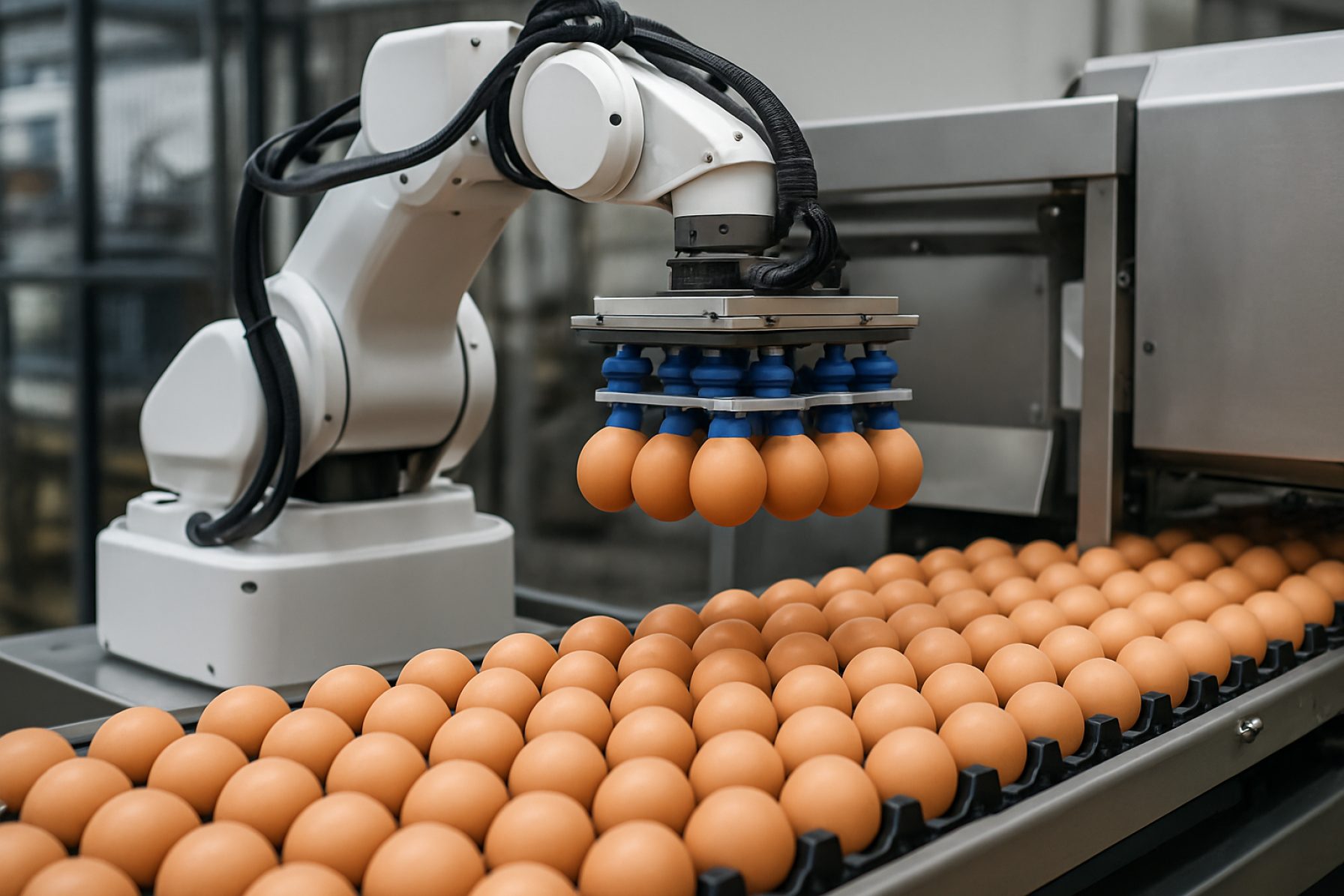How Egg Grading and Packaging Robotics Will Reshape the Industry in 2025 and Beyond. Discover the Cutting-Edge Tech Driving Efficiency, Quality, and Profits.
- Executive Summary: Market Pulse and Key Insights
- Egg Grading Robotics: Technology Overview and Evolution
- Top Robotics Manufacturers and Industry Leaders
- Global Market Size, Growth Projections, and Forecasts Through 2030
- AI and Vision Systems: The Tech Disrupting Egg Quality Control
- Packaging Automation: Integration and Innovations
- Regulatory Environment and Safety Standards
- Case Studies: Real-World Deployments and ROI
- Challenges, Barriers, and Industry Adoption Trends
- Future Outlook: Strategic Opportunities and Next-Gen Solutions
- Sources & References
Executive Summary: Market Pulse and Key Insights
The egg grading and packaging robotics sector is undergoing significant transformation in 2025, driven by automation demands, labor constraints, and tightening food safety standards. The adoption of robotic systems for egg handling, sorting, and packaging is accelerating among major egg producers worldwide, reflecting a broader move towards smart, data-driven operations in the food supply chain.
Leading companies like Moba Group, a Dutch manufacturer regarded as a global leader in egg grading, packing, and processing machinery, have continued to expand their portfolio of fully automated systems. In 2024 and into 2025, Moba’s Omnia line, equipped with advanced vision grading and gentle robotic handling, remains the benchmark for high-throughput egg processing facilities. The company’s recent innovations focus on minimizing human contact, improving traceability, and integrating with digital farm management systems, responding to both biosecurity and efficiency imperatives.
Another key player, Sanovo Technology Group, has further developed robotic solutions that automate not just grading and packing but also palletizing and logistics. Sanovo’s modular systems are designed to scale with producer needs, a crucial factor as egg consumption and processing volumes continue to rise globally. In 2025, new deployments reported by Sanovo highlight a strong trend toward end-to-end automation, with robotics now handling up to 250,000 eggs per hour in the largest installations.
Labor shortages—especially in North America, Europe, and parts of Asia—remain a major driver for investment. Equipment suppliers such as Moody Direct and Ovotrack are seeing increased demand for integration solutions that bridge robotics with existing plant management software, ensuring real-time traceability and compliance with food safety regulations.
Outlook for the next few years points to further convergence of robotics, AI, and IoT. Egg producers are expected to increasingly adopt machine vision for shell quality inspection, automated defect rejection, and even predictive maintenance of equipment. Data from industry bodies such as the International Egg Commission indicate that automation’s share in grading and packaging operations will surpass 60% in high-volume markets by 2027, up from an estimated 45% in 2023 (International Egg Commission).
Overall, the market pulse in 2025 signals rapid innovation, robust capital investment, and a shift toward fully automated, connected egg packing facilities. Companies that offer scalable, interoperable solutions are best positioned to capture growth as regulatory, economic, and demographic trends continue to reshape global egg production.
Egg Grading Robotics: Technology Overview and Evolution
Egg grading and packaging robotics have undergone significant transformation in recent years, driven by automation demands in the poultry industry and advances in machine vision, gentle handling, and data integration. As of 2025, the sector is characterized by a strong presence of highly specialized robotics solutions that automate the processes of egg collection, sorting, grading by quality and size, and subsequent packaging into consumer-ready formats. The adoption of robotics in these processes is aimed at increasing throughput, improving product consistency, and minimizing labor costs while reducing the risk of egg damage.
The evolution of egg grading robotics began with basic mechanical systems capable of simple sorting, but has rapidly advanced to today’s fully integrated, vision-guided robotic lines. State-of-the-art systems utilize optical sensors, high-speed cameras, and artificial intelligence (AI) algorithms to inspect eggs for external defects, cracks, dirt, and size in real time. These data-driven systems can handle tens of thousands of eggs per hour, with leading manufacturers claiming accuracy rates upwards of 99%. Notably, companies such as Sanovo Technology Group and MOBA Group are recognized global leaders, providing large-scale grading and packaging robots that are deployed in major egg processing facilities worldwide. Their platforms integrate grading, traceability, and gentle robotic handling to meet stringent food safety and quality standards.
The period leading up to 2025 has seen a marked shift towards modular and scalable systems, allowing producers of varying sizes to adopt robotic solutions suited to their production volumes. For example, Sanovo Technology Group offers grading systems with capacities ranging from a few thousand to over 250,000 eggs per hour, while MOBA Group is known for its fully automated, flexible lines that can be adapted for specialty or organic eggs. Both companies emphasize hygiene, ease of cleaning, and integration with digital monitoring platforms, reflecting growing regulatory requirements and consumer expectations.
In terms of technology evolution, the next few years are expected to focus on further AI-driven inspection capabilities, greater connectivity for real-time data sharing, and increased energy efficiency. Collaborative robotics, or “cobots,” are anticipated to extend automation beyond grading to include secondary packing and palletization, helping address labor shortages and workplace safety concerns. Emerging players, such as Ovotrack, contribute to digital traceability and logistics integration, supporting end-to-end supply chain transparency.
Looking forward, the sector is poised for continued growth, fueled by the need for productivity and quality assurance in global egg markets. The combination of robotics, data analytics, and digital traceability will define the next phase of egg grading and packaging technology, with leading companies setting the pace for innovation and operational excellence.
Top Robotics Manufacturers and Industry Leaders
The landscape of egg grading and packaging robotics in 2025 is shaped by a handful of specialized manufacturers and industry leaders who are driving automation and innovation across the global egg industry. These companies focus on advanced robotics, vision systems, and integrated solutions to enhance productivity, quality control, and food safety standards.
Among the most prominent names, MOBA stands out as a global leader. Headquartered in the Netherlands, MOBA operates worldwide and is renowned for its extensive portfolio of egg grading, packing, and processing systems. The company’s robotics solutions feature sophisticated vision systems capable of inspecting eggs for cracks, dirt, and irregularities at high speeds, while their automated packing lines are designed to handle delicate products with minimal human intervention. In 2024, MOBA launched the latest iteration of its MR12 robotic packer, which integrates seamlessly with existing grading systems and has been installed in several large-scale operations across Europe and North America.
Another significant entity is SANOVO TECHNOLOGY GROUP, based in Denmark. SANOVO is widely recognized for its comprehensive egg handling and processing systems, including robotic graders and packers that utilize artificial intelligence and machine learning to optimize throughput and reduce labor requirements. The company’s recent advancements include modular robotic packers and automatic palletizing solutions, increasingly sought after in Asia and the Americas as labor costs rise and food safety regulations become more stringent.
In the United States, Diamond Robotics has made a mark with its high-speed egg handling robots designed for both grading and packaging tasks. Their systems are particularly noted for flexibility, enabling customers to adapt quickly to changes in egg sizes and packaging formats.
Within the supply chain, companies like Ovotrack are providing indispensable traceability and logistics solutions that integrate with robotic graders and packers, ensuring end-to-end data management and compliance with traceability standards required by major retailers and regulators.
Looking ahead into the next few years, the outlook for egg grading and packaging robotics is one of continued automation and digitalization. Manufacturers are investing heavily in artificial intelligence, machine vision, and modular robotics, aiming to increase system flexibility and reduce downtime. Industry leaders are also responding to the growing demand for sustainability by developing energy-efficient machinery with lower carbon footprints. As egg producers worldwide face pressure to boost efficiency, ensure biosecurity, and address labor shortages, these leading robotics manufacturers will remain at the forefront of industry transformation.
Global Market Size, Growth Projections, and Forecasts Through 2030
The global market for egg grading and packaging robotics is experiencing robust growth, driven by increasing automation in the food processing sector, labor shortages, and the rising demand for high-throughput, hygienic handling of eggs. As of 2025, the market is characterized by the ongoing transition from manual to automated systems, especially among large-scale egg producers in North America, Europe, and Asia-Pacific. Key players such as Moba Group, Sanovo Technology Group, and Ovobel are at the forefront, continuously investing in advanced robotics, machine vision, and AI-driven grading solutions.
Current industry data indicates that installations of robotic egg grading and packing systems have accelerated since the COVID-19 pandemic, as producers address labor constraints and focus on food safety. For instance, Moba Group—one of the world’s largest suppliers of egg grading and packaging equipment—has reported sustained demand for its fully automated lines, which can process up to 216,000 eggs per hour with minimal human intervention. Similarly, Sanovo Technology Group has expanded its robotics portfolio to include collaborative robots (cobots) for flexible, space-efficient packing solutions, targeting both industrial-scale and mid-sized operations.
Forecasts for the period through 2030 suggest a compound annual growth rate (CAGR) in the high single digits for the egg grading and packaging robotics market. This optimistic outlook is supported by several factors:
- Continued consolidation within the egg industry, leading to larger, more centralized facilities that benefit from automation.
- Stringent food safety regulations, especially in the EU, US, and Japan, incentivizing adoption of contactless robotic systems.
- Emergence of smart robotics with integrated AI and IoT, enabling real-time monitoring, predictive maintenance, and optimized throughput.
Asia-Pacific is expected to witness the fastest growth, driven by rising egg consumption and rapid modernization of agricultural practices in China, India, and Southeast Asia. Meanwhile, North America and Europe remain mature markets, but are seeing upgrades to existing facilities with state-of-the-art robotics from suppliers like Moba Group and Sanovo Technology Group.
By 2030, the global market for egg grading and packaging robotics is projected to be significantly larger than in 2025, with automation becoming the industry norm rather than the exception. Ongoing innovation from established manufacturers and new entrants alike will play a pivotal role in shaping the competitive landscape and driving efficiency gains across the egg supply chain.
AI and Vision Systems: The Tech Disrupting Egg Quality Control
Egg grading and packaging robotics are undergoing rapid transformation in 2025, primarily driven by the integration of advanced AI and vision systems. These technologies are reshaping how eggs are sorted, graded, and packed, ensuring higher accuracy, speed, and consistency than ever before. Traditionally, egg grading relied on manual inspection or basic mechanical sorting, but the latest robotic solutions leverage high-speed cameras and deep learning algorithms to detect cracks, dirt, internal defects, and subtle quality indicators invisible to the human eye.
Major industry players such as Moba Group and Sanovo Technology Group have made significant advancements in this domain. Moba Group’s latest graders, launched in late 2024, feature AI-powered vision modules capable of inspecting up to 250,000 eggs per hour, identifying micro-cracks and shell abnormalities with sub-millimeter precision. Sanovo Technology Group has similarly upgraded its robotic packing lines, integrating real-time image analysis systems that instantly classify eggs according to multiple criteria, from shell strength to yolk color, and facilitate gentle robotic handling to minimize breakage.
In parallel, Ovobrand and other vertically integrated egg producers are adopting these robotics not just for quality control but to enhance traceability and data collection. By logging quality metrics for each individual egg, producers can optimize flock management and respond swiftly to biosecurity or supply chain issues—a capability increasingly valued by retailers and regulators.
The competitive landscape in 2025 is also seeing new entrants and collaborations. Robotics specialists such as Stäubli are partnering with established egg equipment manufacturers to embed flexible robotic arms and AI-enabled vision systems into existing grading and packing lines. This modular approach is particularly attractive to mid-sized producers seeking to scale automation without complete facility overhauls.
Looking ahead, experts anticipate further convergence between robotics, cloud-based analytics, and Internet of Things (IoT) platforms. Real-time remote monitoring, predictive maintenance, and even automated egg-to-carton traceability are expected to become standard in the next few years, driving efficiency and compliance. As regulatory standards and consumer expectations around food safety rise, the adoption of AI-driven egg grading and packaging robotics is poised to accelerate, positioning the sector for continued innovation and investment.
Packaging Automation: Integration and Innovations
Egg grading and packaging robotics are rapidly transforming the egg industry’s approach to efficiency, product consistency, and food safety. As of 2025, leading egg-producing countries are accelerating investments in sophisticated automation solutions, integrating robotic systems into both grading and packaging lines. The implementation of robotics addresses labor shortages, increases operational throughput, and enhances traceability—key factors given ongoing consumer and regulatory demands.
Robotic graders, equipped with advanced machine vision and artificial intelligence, are now capable of assessing egg quality based on size, shell integrity, and cleanliness in real-time. These systems are designed for high throughput; for example, some industrial robotic graders process over 250,000 eggs per hour, minimizing human handling and reducing the risk of contamination. Integration with automated packing systems allows for immediate and gentle placement of eggs into packaging, optimizing both speed and product safety.
Major manufacturers in this sector include Sanovo Technology Group, a Danish company specializing in egg processing and packaging machinery, and Moba, a Dutch firm recognized for its egg grading, packing, and processing technology. Both companies have emphasized modular robotic systems that can be adapted to different plant sizes and regional regulatory requirements. For instance, Moba’s latest robotic packing lines use vision-guided pick-and-place robots for fast, gentle, and accurate placement of eggs, reducing breakage and labor needs. Sanovo Technology Group continues to innovate with end-to-end automation, focusing on data connectivity for full traceability and preventive maintenance.
Another important player, Ovotrack, provides traceability solutions that integrate with graders and packers, ensuring that every egg’s journey from farm to retail is recorded—a feature increasingly mandated by food safety authorities. These digital integrations support real-time monitoring and remote diagnostics, crucial for maintaining quality standards and minimizing downtime.
Looking ahead, the next few years are expected to bring further advancements in robotics, including increased use of AI for defect detection, self-optimizing machines, and more sustainable packaging systems compatible with automated handling. Automation is anticipated to become accessible to medium and even smaller producers as costs decline and modular systems proliferate. This ongoing evolution is set to drive productivity, reduce waste, and meet the growing global demand for safe, high-quality eggs.
Regulatory Environment and Safety Standards
The regulatory environment for egg grading and packaging robotics in 2025 is shaped by evolving food safety standards, automation guidelines, and industry-specific requirements. Regulatory bodies such as the United States Department of Agriculture (USDA) and the European Commission (European Commission) set the framework for hygiene, traceability, and product quality in egg processing, impacting how robotics are designed and deployed.
Robotic systems used in egg grading and packaging must comply with stringent food contact material regulations, as well as machinery safety standards. In the U.S., the USDA’s Egg Products Inspection Act stipulates conditions for grading, sanitation, and labeling, with increasing emphasis on automation that supports consistent quality and traceability. Similarly, the European Union’s egg marketing standards (Regulation (EC) No 589/2008) require clear traceability and hygiene, pushing manufacturers to design robotic solutions with integrated vision systems and real-time tracking capabilities.
Leading manufacturers like Moba Group, a Dutch-headquartered global leader in egg grading and packing equipment, and Sanovo Technology Group, based in Denmark, invest heavily in ensuring their robotic solutions meet or exceed international regulatory requirements. These companies typically engineer their robotic graders and packers with stainless steel components, clean-in-place systems, and safety interlocks that facilitate compliance with both North American and European standards. Certification to standards such as ISO 22000 (food safety management) and CE marking for machinery safety is now a baseline expectation for robotic systems entering the market.
In 2025, there is a notable trend toward harmonization of safety standards across regions, driven by globalization of food supply chains and growing cross-border trade. This is reflected in the efforts of industry groups like the International Egg Commission (International Egg Commission), which advocates for best practices and regulatory alignment. Increasingly, robotic systems are being equipped with advanced sensors and data logging capabilities, enabling continuous monitoring and rapid reporting in line with traceability requirements outlined by regulatory authorities.
Looking ahead, the regulatory landscape is expected to further tighten as consumer demand for transparency and food safety grows. Anticipated updates may include more rigorous mandates for digital traceability, expanded requirements for allergen management, and stricter validation of robotic systems used in direct contact with eggs. Manufacturers are responding by enhancing system validation protocols and collaborating with regulators to ensure early compliance with emerging standards, helping to future-proof their automation solutions in a rapidly evolving market.
Case Studies: Real-World Deployments and ROI
The deployment of robotics in egg grading and packaging has accelerated sharply in the past few years, driven by labor shortages, heightened food safety requirements, and the need for operational efficiency. Recent case studies from 2024 and 2025 illustrate both the technological advancements and the measurable return on investment (ROI) realized by major producers worldwide.
One notable example comes from the Netherlands, where Moba, a global leader in egg grading and packing solutions, has implemented its Moba Forta series at large-scale facilities. These systems automate the detection, sorting, and gentle packing of eggs at speeds of up to 200,000 eggs per hour. Customers report reductions in labor costs by up to 60% and improved grading accuracy, leading to fewer product recalls and higher customer satisfaction. The integration of artificial intelligence-driven vision systems enables real-time defect detection and traceability, a critical feature for compliance with evolving food safety regulations.
In the United States, Sanovo Technology Group has deployed its robotic packing arms and vision-based graders at several leading egg producers. According to data from Sanovo, producers have seen ROI periods as short as 18–24 months, thanks to a combination of labor savings, increased throughput, and reduced product breakage. Their systems, such as the Sanovo OptiGrader, can process up to 190,000 eggs per hour with minimal human intervention, and modular designs allow for easy scaling as production needs grow.
Japan’s NABEL has also reported successful rollouts of its automated egg grading lines at major Asian egg farms. The company’s robotics integrate advanced sensors for crack and dirt detection, optimizing yield and meeting strict quality standards. Farms using NABEL systems have experienced up to 40% faster processing times and significant reductions in manual handling errors.
Looking ahead to 2025 and beyond, producers worldwide are expected to further embrace robotics for both new facilities and retrofit projects. The ongoing integration of data analytics platforms and cloud connectivity will drive additional ROI by enabling predictive maintenance, remote diagnostics, and production optimization. These advances are likely to make automated egg grading and packaging not only a competitive advantage but a necessity in high-volume operations worldwide.
Challenges, Barriers, and Industry Adoption Trends
The adoption of robotics for egg grading and packaging continues to accelerate into 2025, yet the sector faces a distinctive set of challenges and barriers that shape its trajectory. The egg industry’s move toward automation is driven by labor shortages, rising operational costs, and the need for consistent product quality. However, several factors impact the pace and extent of adoption across diverse markets.
One central challenge is the capital-intensive nature of robotic solutions. State-of-the-art egg grading and packaging machines, such as those developed by Moba Group and SANOVO Technology Group, require significant upfront investment. This can be a substantial barrier for small and medium-sized egg producers, who may struggle to justify or finance the transition from manual or semi-automated systems. These leading companies offer modular systems that can be scaled, but cost remains a primary concern, especially in emerging markets.
Integration with existing infrastructure also poses obstacles. Many egg processing facilities operate legacy conveyor and handling systems that are not readily compatible with advanced robotics. Upgrading entire lines can be disruptive, necessitating downtime and retraining of staff. Moreover, the delicate nature of eggs demands highly specialized handling technologies to minimize breakage and maintain food safety standards—criteria that not all automation vendors can reliably meet at scale.
Workforce transition is another significant barrier. While automation can address labor shortages, it also requires existing employees to acquire new technical skills. Companies like Moba Group and SANOVO Technology Group have responded by enhancing training and service offerings, but the shift can be complex for organizations with limited resources.
From an industry adoption perspective, larger producers are leading the way. In 2025, global integrators and major egg processors are increasingly investing in high-speed robotic grading and packaging lines, seeking to optimize throughput, traceability, and hygiene. For example, Moba Group has deployed its Omnia series in several high-capacity facilities worldwide, reflecting this trend toward large-scale adoption.
Looking ahead over the next several years, industry observers expect continued momentum in automation, with broader adoption fueled by falling technology costs, increasing labor pressures, and evolving food safety regulations. Partnerships between robotics suppliers and egg industry stakeholders are expected to accelerate, with the market gradually opening to mid-sized producers as modular, retrofittable solutions become more accessible. However, regional disparities in infrastructure and investment capacity will remain important factors influencing the global landscape of egg grading and packaging robotics.
Future Outlook: Strategic Opportunities and Next-Gen Solutions
The egg grading and packaging robotics sector is set for significant advancement in 2025 and the upcoming years, driven by automation demands, labor shortages, and the need for biosecurity in food handling. The global egg industry, producing over 1.3 trillion eggs annually, is under pressure to standardize quality, traceability, and efficiency—factors that are fueling investments in next-generation robotic systems.
One of the pivotal trends is the adoption of AI-powered vision systems and advanced robotics for high-speed, non-destructive egg grading. Leading manufacturers such as Sanovo Technology Group and Ovobel are developing integrated lines capable of handling over 250,000 eggs per hour, with real-time defect detection and automated rejection of off-spec eggs. These systems leverage deep learning to identify microcracks, dirt, and internal defects, setting new benchmarks for accuracy and labor cost savings.
Packaging automation is also evolving. Robotics from Moba Group—one of the largest global suppliers—are now widely deployed in new and retrofitted facilities. Their robotic case packers and palletizers enable rapid SKU changes and gentle handling, addressing both supermarket supply chain demands and regulatory traceability requirements. The company’s recent investments in modular robotics are designed to support flexible, scalable operations for both large integrators and mid-sized producers.
China is emerging as a significant market for egg processing robotics, with domestic firms increasingly collaborating with European partners to localize automation technologies. This trend is expected to accelerate as domestic consumption continues to rise and producers seek export-market compliance. Additionally, North America’s producers are actively modernizing their facilities to comply with animal welfare and food safety regulations, further driving adoption of robotic solutions.
Looking ahead, the industry anticipates a surge in demand for cloud-connected systems that provide predictive maintenance, batch-level traceability, and seamless integration with farm management platforms. Companies like Sanovo Technology Group are already piloting such solutions, leveraging IoT for real-time monitoring and remote diagnostics.
- Strategic opportunities include expansion into emerging markets where manual processes still dominate, offering immediate productivity gains.
- Next-generation solutions are expected to focus on sustainability, reducing energy and packaging material use while maximizing egg shelf life and safety.
- Collaborative robotics (cobots) are poised to make inroads into small and medium-sized operations, democratizing access to advanced automation.
In summary, 2025 and the following years are likely to see egg grading and packaging robotics become standard in progressive facilities worldwide, setting new expectations for efficiency, safety, and product quality.
Sources & References
- Moba Group
- Moody Direct
- Ovotrack
- International Egg Commission
- MOBA Group
- Ovotrack
- Ovobrand
- Stäubli
- European Commission
- NABEL











